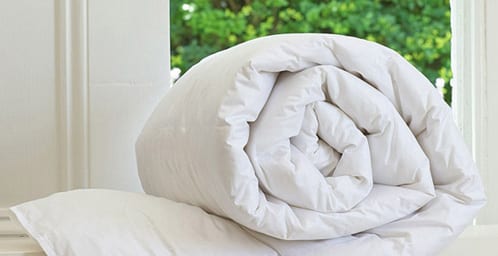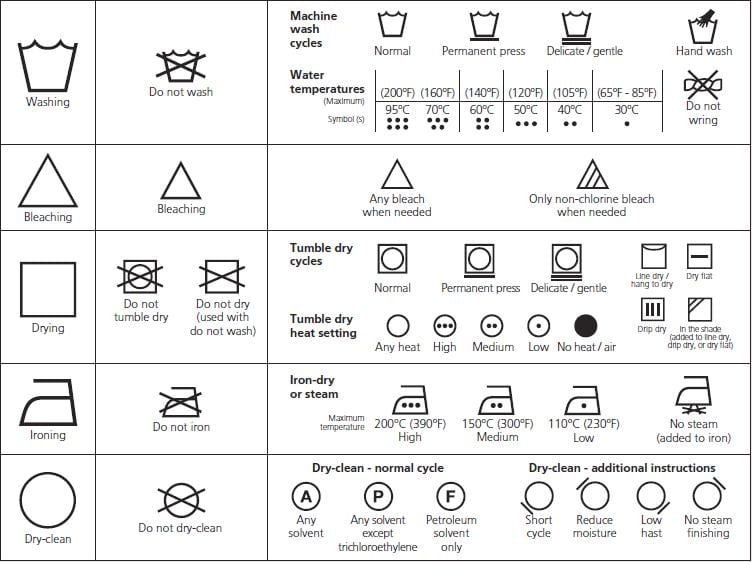How to Wash and Maintain Your Duvet
Wrapping yourself in a freshly cleaned duvet is a truly wonderful feeling. On this page, you can find some helpful information on how to wash, care for and generally maintain your duvet.
 Wash and Maintain your Down Duvet
Wash and Maintain your Down Duvet
Maintain your Duvet and extend its Life
Whether your duvet lasts for 5 or 15 years does not only depend on its quality (though it is an important factor) it also depends on how well the duvet is maintained. Do you want to enjoy your new duvet for as long as possible? Here are a few guidelines you can follow to ensure maximum longevity of your down duvet.
Air and Dry? Yes!
Down duvets are easy to clean: simply ventilating your duvet ensures that it stays dry, smells pleasant and maintains its fill power. This must be done in dry weather. However make sure that your duvet is not exposed to direct sunlight. A temperature higher than 37°C will cause the down to lose its elasticity. When down clumps together, you can shake it loose by hand or put it in a dryer with a dampened (and well wrung) towel. The warm, moist air in the dryer loosens the tufts of down and creates airiness without losing fill power.
Beat and Vacuum? No!
Please do not use a carpet knocker or vacuum cleaner to shake and clean your duvet as it might cause damage to the outer fabric. Pores in the fabric will expand and the feathers and down might come out. The fabric cover is very tightly sewn and prevents any dust from entering. Tapping or vacuuming can damage the down because it breaks down the delicate intertwined tufts inside. If you need to clean the surface of the duvet we recommend a light brushing and a moderate shaking to best maintain your duvet.
Avoiding pressure? Yes!
Down duvets have impressive insulating properties. Delicate tufts of down are intertwined to trap a layer of air and keep the cold at bay. If you want your duvet to retain its warmth, you should not lie down on top of the duvet or apply excessive pressure to it. If the down clusters are repeatedly compressed they will eventually break down, which will diminish the fill power of the down.
 You might consider washing your duvet yourself
You might consider washing your duvet yourself
Washing Machine? It depends
While most down duvets are machine-washable, always follow the washing instructions printed on the label and don’t wash the duvet if the label advises against it. A trip to the washing machine can be a very stressful process for a down duvet or down pillow. Washing a duvet yourself can be complex and often risky. We recommend hiring a specialised company, as heat, pressure, residual moisture, and chemical stress can degrade the down. The relatively low cost of a professional cleaning outweighs the complex requirements of washing the duvet yourself.

Tips for machine cleaning a down duvet
- Check the duvet for small holes and perforations before washing
- Choose the lowest possible temperature
- Choose the lowest possible number of revolutions per minute (RPM)
- Optional: program fine or wool wash. If available: down program
- Economical use of a detergent specialising in down
- Avoid other fabric softeners or detergents
- An additional rinse for the complete removal of detergent residue
- Use of a sufficiently sized washing machine
- Use of a sufficiently sized dryer
- Add some clean tennis balls to the dryer
- After the dryer cycle, check for residual moisture and, if necessary, dry again
- Shake well, yet gently
Cleaning an Eiderdown duvet
An eiderdown duvet differs from a down comforter in the structure of the down. Duck and goose downs generate their insulating power by creating pockets of air within the space enclosed by the duvet casing. In eiderdown the same principle applies but in a much smaller space because the eiderdown ducks produce a one of a kind down with micro air chambers. What this means is that they are able to trap air better for optimal insulation. Our recommendations to wash and care for your duvet do not apply directly to this kind of down. Indeed the technical requirements to wash and care for an eiderdown duvet are significantly more complex.
All natural fillings such as down and feathers are evolutionarily optimised to protect against external environmental influences. Among other things, eiderdown has a protective residual fat layer that provides an antibacterial effect. Therefore, any use of non-specialised detergent will chemically attack and deteriorate this layer. For eiderdown, it is important to note that the microstructure is more susceptible to foreign material sticking than the structure of other down types.
Depending on the manufacturer, an eiderdown duvet can be washable, but evaluate your own knowledge and technical equipment. The cost of professional cleaning is probably worth your peace of mind. Additionally, please keep in mind that owing to its self-cleaning power, an eiderdown duvet rarely, if ever needs to be washed. It is generally sufficient to shake and ventilate daily to restore the micro-air chambers.
How often does a down duvet have to be washed?
During the process of quality control steps are taken to ensure that the down is free from chemical or physical foreign bodies and also that it carries the optimum residual fat content. As a result, down does not absorb long-term odours. Together with the antibacterial effect, down therefore has a natural protection against odour formation or against the accumulation of foreign substances.
As a result of these natural properties, both down and eiderdown duvets need to be washed quite rarely (we recommend every 3-5 years). In addition, the high-quality down-proof and breathable outer fabric protects the filling of your duvet. The third layer of protection is your bed linen and by regularly cleaning this, you also protect the duvet.
Down pillows wash and care
Down pillowsare basically smaller versions of down duvets, but they suffer more strain. Therefore we suggest washing them every year.
Drying your down pillows and duvet
We advise drying duvets and down pillows in a dryer. As with the washing of both down products, there are some challenges to overcome when drying, which require the necessary environment and equipment. If done improperly, customer feedback shows that it can lead to unpleasant odours. There are two possible causes for this:
- The first possible cause is high residual moisture. The associated mould growth is due to insufficient ventilation.
- Alternatively, the down duvet or down pillows may have been exposed to heat that exceeds the safe amount, such as direct sun. As a result, the residual moisture in the down could erode the protection and destroy the natural odour defence system of the down. Without this natural protection, unpleasant odours can accumulate on the down product and disrupt your comfort.
If you have other questions on how to maintain your duvet, contact us or check out our Frequently Asked Questions.